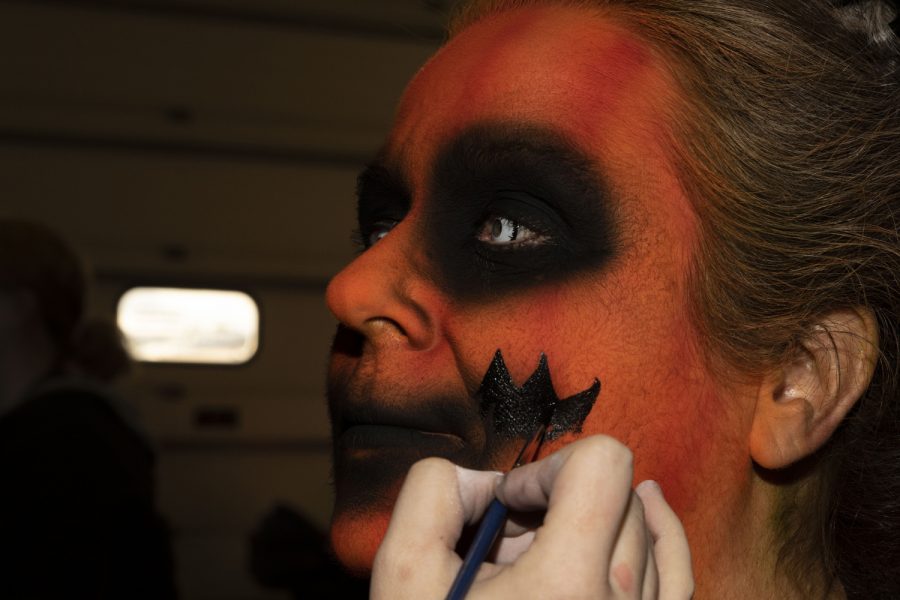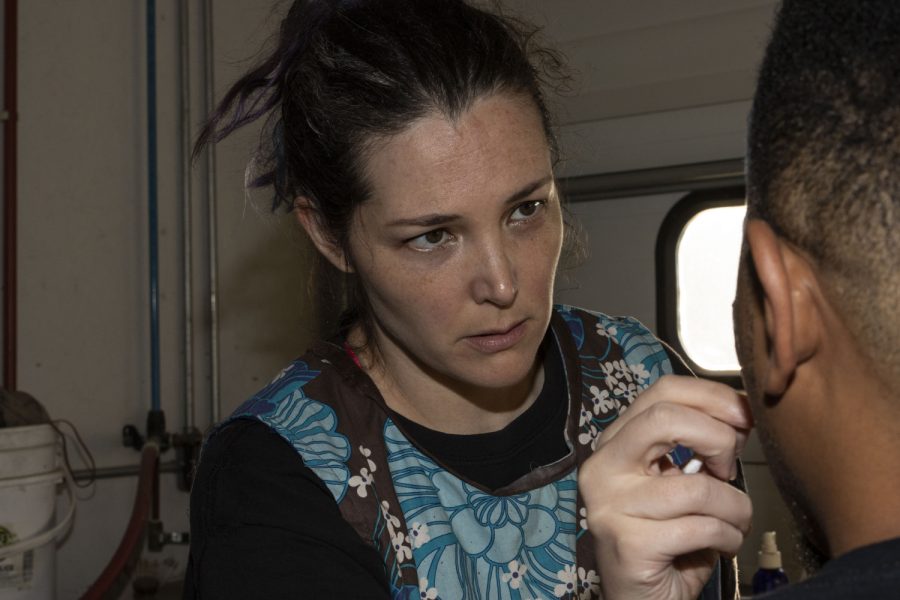Make-up artist Zoe Harrison paints detail work onto Deborah Christensen-Andrew at Scream Acres in Cedar Rapids on Saturday, Oct. 19, 2019. Christensen-Andrew plays “The Pumpkin Mash” (Katie Goodale/The Daily Iowan)
Making monsters through makeup: How haunted houses create horror
For weekends during the month of October, everyday people transform into terrifying monsters of the night, for the sake of the scare.
October 30, 2019
In a large farm shed at Scream Acres in Atkins, Iowa, everyday people are transformed into terrifying creatures, ready to haunt the grounds at night. The light of the late afternoon spills through the windows as actors in the process of becoming more terrifying laugh and mingle with one another over the hum of air compressors and the hiss of airbrush paint.
Actor Bob Lattimer, a machinist during the week and the Butcher by the weekend, sits in a chair facing a mirror running along the wall. Makeup and special effects artist Brent Edgett stands in front of him, carefully spraying red paint onto his face.
Edgett has spent six years with Scream Acres, developing his skills as a horror effects artist from online tutorials and haunter conventions, where haunting aficionados meet to learn new skills and see the newest tools in the industry.
Each character is given their own look, some with immense detail through the use of waterproof airbrush paints, fleshy stick-on prosthetics, and costuming.
“We try to make up different looks for different zombies to fit a character better, but sometimes if we’re running short on makeup artists, we’ll do everything as simple as we can,” Edgett said. “Otherwise we try to keep certain things for certain people; like Bob here, he has an exit wound on his head from a bullet that’ll be going in and just blowing his brains out.”
Lattimer, after being painted, will don a bloody apron and a machete to become the Butcher.
“I come at them real hard, and I have a loud voice. So, I scream at them, YOU’RE ALL GONNA DIE!” he boomed in a voice that filled the shed.
Lattimer and his wife have been scaring at the farm together for around five or six years.
Next to Lattimer, Brian Smith, who plays the zombie sheriff, applies a wet prosthetic to his face. While his day job is at Collins Aerospace in Cedar Rapids, his weekends in October for the past 10 years have been spent as a scarer.
“It’s one of those things you can actually use your talents,” he said. “I do like scaring people, and I like using my creativity in the different costumes you can put on. I also like when I come out here, because everyone here is like a family. You don’t have to feel weird when you talk about Halloween or scaring or going someplace or watching horror movies. You’re around family who understands it.”
Along with realistic facial prosthetics that make the skin look rippled, torn, or rotten, Smith wears colored contacts and a sheriff’s uniform to complete his zombie look.
Sarah Hinds, a makeup artist who has been with Scream Acres for the past three years, prepped Smith’s prosthetics for painting after they had been securely attached to his face. The University of Iowa art school alum joined the Scream Acres team after having done theater makeup throughout high school and said she had missed doing it.
“I wondered if I would be good enough to do it here, and I did an audition and they took me,” she said. “They said I could only do acting or makeup, and I’m like, ‘Makeup, done.’ ”
Her audition was an ultimate special-effects battle.
“For the makeup, they don’t do an audition every year, but they did it my year,” she said. “They did it like Face Off, they had two of us on Brian, and we each got half his face for 15 minutes, and they said, ‘Make your zombie look.’ ”
While Hinds said she likes doing delicate face work, she mostly does parts work, transforming body parts into something cohesive with the look.
“If they say, we need dirty hands, this person needs a neck, this person just needs black eyes under their mask, I do a lot of that,” she said. “It is not my favorite, but I’m very good at it.”
Hinds said different elements can make a look more terrifying, like adding blood where it would realistically be, changing someone’s teeth, or calling attention to their eyes.
Edgett agreed, saying that the eyes can really transform someone.
“People wear contacts in their eyes, and it basically sells a character right away. It’s differentiating from the normal look,” he said. “That’s why clowns are scary, because they have extended features — bigger eyes, bigger mouths. People love blood splatter, dark around the eyes so their eyes stand out.”
While Hinds credits the scaring to the actors, she said the makeup’s role is to assist in selling the character’s aesthetic.
“The experience in there, in my opinion, is so real feeling, because every detail is paid attention to, kind of like Disney World,” she said. “If you’re that type of person who can suspend disbelief, it feels like you’re in it, and it’s very scary, and you’re trapped in there, so when you see a bloody face, you’re like, ‘Holy crap, they’re going to hurt me.’ I don’t think it’s the makeup that does it, but if it wasn’t done right, it would not suspend disbelief, it would be like, ‘Oh, that makeup looks really cartoonish.’ ”
The haunted house industry, while operating in the small window of October, generates between $300 million and $500 million, according to AmericaHaunts.com.
Makeup artist Zoe Harrison, who started with Scream Acres last year, said attention to detail was key.
“Stuff that is the most realistic and most detail work probably is what impresses people the most,” she said. “Detailed work is really what gets people, because anybody can slap on black and white and be a skull face, so we really do try to go above and beyond and impress the crowd and try to put ourselves above the rest.”
While Harrison went to Capri College in Cedar Rapids, she said she learned a lot of special-effects makeup from experimenting on her own and from watching YouTube tutorials. While she usually does traditional makeup at a salon in Independence, she said this is her fun time of year.
“I definitely get to be creative here,” she said. “A lot of it I do the same characters, but we change it up. It’s a creative outlet for me. It’s just a lot of fun, we’re kind of like a big family here.”

